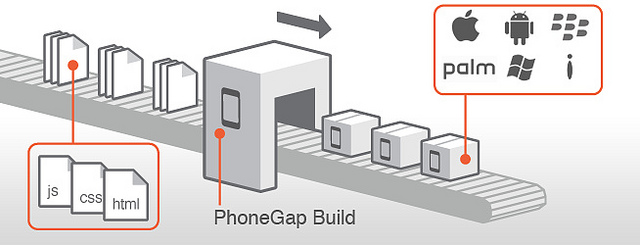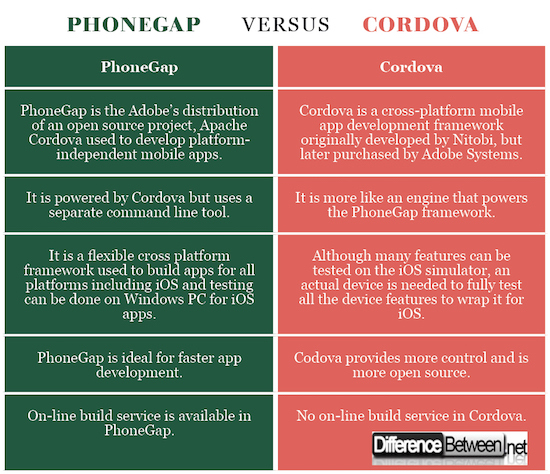Difference Between PhoneGap and Cordova
Both are the most common terms used in the mobile application development community. The idea is to create an application that will work efficiently on all mobile platforms including Android, iOS, and Windows. However, building a mobile application requires a framework.
PhoneGap and Cordova are the most common cross-platform frameworks used to create, develop, and develop applications for all mobile devices across all major platforms by using standard web technologies such as HTML, CSS, and JavaScript.
This article highlights some key points comparing the two frameworks on various fronts.
What is PhoneGap?
Building applications for mobile devices in each of the platform – iOS, Android, and Windows – is a daunting task and requires knowledge and different languages and frameworks. PhoneGap makes this job a whole lot easier by leveraging standard web-based technologies and languages such as HTML, CSS and JavaScript to build platform-independent mobile apps. PhoneGap provides a framework to successfully create, develop, and deploy mobile applications for devices across all platforms by bridging the gap between web applications and mobile devices. PhoneGap is the Adobe’s distribution of an open source project which was renamed as Apache Cordova under the stewardship of Apache Software Foundation.
What is Cordova?
Cordova is a cross-platform application development framework originally developed by Nitobi but was later changed to PhoneGap after Adobe Systems acquired Nitobi in October 2011. Later Adobe contributed the codebase of PhoneGap to Apache Software Foundation (ASF) for incubation. To make it work for large businesses and organizations and to maintain transparent governance, PhoneGap was renamed to Cordova under the ownership of Apache. Cordova is more like an engine that powers the PhoneGap framework. The relationship of Cordova to PhoneGap is like how WebKit is related to Chrome or Safari. It is the one-stop destination for those interested in contributing to PhoneGap open source projects.
Difference between PhoneGap and Cordova
Introduction of PhoneGap and Cordova
PhoneGap is a cross-platform mobile application development framework by Adobe Systems used to develop platform-independent mobile applications. It uses standards-based web technologies such as HTML, JavaScript, and CSS to bridge the gap between web apps and mobile devices. Originally created by Nitobi Softare and later purchased by Adobe Systems, PhoneGap is based on the open-source Apache Cordova Project.
Adobe Systems released an open source version of the software and named it Apache Cordova. It’s a framework used to build Native Mobile Applications using HTML5, CSS, and JavaScript.
Framework of PhoneGap and Cordova
Both PhoneGap and Cordova are open-source cross platform frameworks but with different names. Cordova, at this point, is the open source platform that was formerly called PhoneGap. Both the terms can be used interchangeably because they both can help build mobile applications using HTML, CSS, and JavaScript. PhoneGap is basically the Adobe’s distribution of Cordova but with a few additional custom packages and tweaks. The difference lies in the name except PhoneGap services are owned by Adobe which may not be always free to use. PhoneGap is an open source distribution of the Cordova framework.
Platform of PhoneGap and Cordova
PhoneGap makes it easy for you to develop platform independent apps or hybrid apps thereby reducing the time consuming process learning platform specific API’s and languages. It is also the most flexible framework used to develop apps for all platforms and devices including iOS, Android, Windows Phone, BlackBerry 10, Amazon Fire OS, etc using PhoneGap build services. Cordova makes sure it works on all Android devices but you need an actual Apple device to fully test all the device features to wrap it up for iOS. Though most of the features can be tested using the iOS simulator installed with iOS SDK and Xcode.
Performance of PhoneGap and Cordova
Most of the time, hybrid works really well over native apps which are using native components like “View” and “Text” over web components like “div” or “span”. The main advantage of hybrid apps is their ability to build for all major platforms and that too, with a single codebase. Additionally, JavaScript engines are evolving rapidly and browsers are also advancing on all fronts, owing to the high-performance hardware that only adds to the GPU speeds thereby increasing single thread performance. However, even with the powerful animation capabilities of the HTML5, the performance of hybrid apps does not match that of native apps.
Future of PhoneGap and Cordova
- PhoneGap is an open-source implementation of open standards that was rebranded as Apache Cordova under the ownership of Apache Software Foundation. Think of Cordova as the engine that powers PhoneGap. The relationship of Cordova with PhoneGap is like WebKit’s relationship with Chrome or Safari. Cordova is owned by Apache and will always remain open source and free to use. However, PhoneGap is the distribution of Cordova and may even charge for the additional services. PhoneGap is the proprietary product of Adobe and the framework’s future is in the hands of Adobe.
PhoneGap vs. Cordova: Comparison Chart
Summary of PhoneGap and Cordova
Both the terms PhoneGap and Cordova are often used interchangeably and both are open-source frameworks used to build platform-independent mobile applications using HTML, CSS, and JavaScript. However, the difference lies in the name. PhoneGap is basically an open source distribution of Cordova which was previously owned Adobe Systems but the initial codebase was later handed over to Apache Software Foundation, so Apache rebranded it as Apache Cordova to keep it open source and free to use. In simple terms, PhoneGap is Cordova plus some additional Adobe stuff and custom packages. Think of Cordova as an engine that powers the PhoneGap framework.
- Difference Between Caucus and Primary - June 18, 2024
- Difference Between PPO and POS - May 30, 2024
- Difference Between RFID and NFC - May 28, 2024
Search DifferenceBetween.net :
Leave a Response
References :
[0]Gifford, Matt. PhoneGap Mobile Application Development Cookbook. Birmingham: Packt Publishing, 2012. Print
[1]Kovalenko, Andrey. PhoneGap By Example. Birmingham: Packt Publishing, 2015. Print
[2]Camden, Raymond. Apache Cordova in Action. New York: Manning Publications, 2015. Print
[3]Image credit: https://www.flickr.com/photos/doctorserone/5682929553
[4]Image credit: https://upload.wikimedia.org/wikipedia/commons/thumb/c/ce/Cordova-logo-dark-gray-by-gengns.svg/640px-Cordova-logo-dark-gray-by-gengns.svg.png



